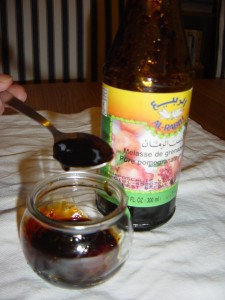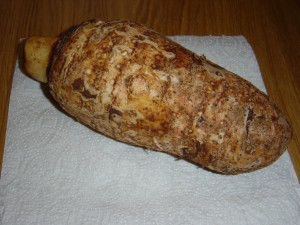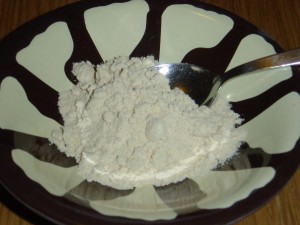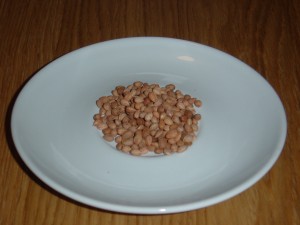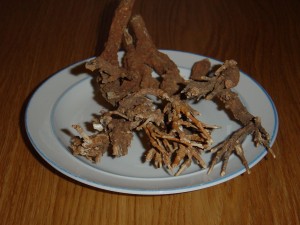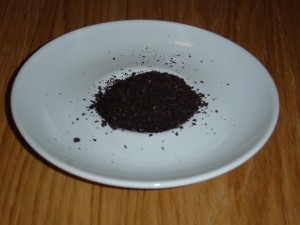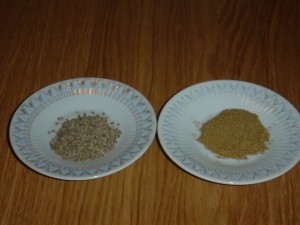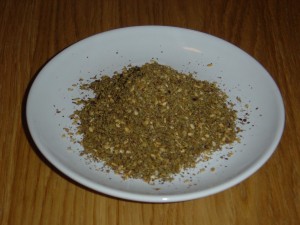Ashtah, (Lebanese Clotted Cream)
In Lebanon, people usually buy it ready prepared. Ashtah does not separate during cooking. That is why it is used as a filling in some pastries like Znoud Al-Sit (lady’s arms, rolled pastry filled with ashtah and deep fried, this looks rather like spring rolls). It is also served as a cold filling or topping, it is even eaten on its own with honey and nuts.
Burghul, (known also as Bulgar Wheat, bulgur)
Basically the wheat has been parboiled, dried then ground to produce three main grades, coarse, medium fine and vey fine:
1. Coarse burghul, khishin is mainly used in pilavs such as Burghul Bi’Dfeen,
2. Medium fine, burghul na em is used for all sorts of Kibbeh and salads such as Tabbouleh.
3. Very fine burghul, frayfeerah which is the remnant, flour-like this is rarely used nowadays in recipes.
Dibs El Rumman, (Pomegranate Molasses)
This is manufactured from the juice extracted from the seeds of sour pomegranate. It looks like very dark sugar Molasses. It has a sweet and sour taste, frequently used in salads, stuffings, and other dishes.
Extracted from the Carob tree pods (ceratoniasiliqua) native to Lebanon and the Mediterranean region. It has a thick treacly consistency (like British Black Treacle). This is eaten as a dessert with bread and often mixed with tahini (roughly 2 tbsp of tahini for 150ml of Dibs El Kharnoub), or simply people eat it on its own. The older generation even used to recommend dibs-tahini mixture as a way to relieve constipation. Nowadays, Dibs El Kharnoub has been adopted by Western culinary because of its nutrient benefits. The following website can tell you more about it:
(picture)
http://www.slowfoodbeirut.org/index_inv.php?c=inv19
El Ass or Kelqass, (Colocasia or Taro)
Brownish colour, Colocasia is a root vegetable brownish in colour, makes lovely dishes, especially for vegans. It is usually sold in Lebanese, Turkish and Greek stores.
Kishik
Made from burghul soaked in yoghurt (laban), and left to ferment for several days, adding milk at a later stage. It is then dried and ground. As you might expect, it is processed commercially. It is sold in Lebanese stores, it resembles flour but more of a pale white. It is used to make soups and some savoury pastries like Mana eesh b’ Kishik, flat bread dough topped with Kishik mixture (Kishik powder mixed with extra virgin olive oil, chopped onions and tomatoes) and baked in the oven.
Mahlab, (also known as Mahalab)
A spice extracted from the kernel of the Mahalab cherry tree. It comes in the form of whole kernels or ground into powder. It is used to flavour some breads, cakes and biscuits such as Mamoul.
http://www.theepicentre.com/Spices/mahlab.htmlhttp://www.uni-graz.at/~katzer/engl/Prun_mah.html
Ma al-Ward, (Maward, Rose Water)
Water extracted from the petals of the Damask rose, it is used as a fragrant ingredient in most Lebanese desserts. Also it is used in the production of rose water syrup which when diluted in drinking water, makes a lovely refreshing summer drink.
Mazaher, (Orange Blossom Water)
Water extracted from the blossoms of the bitter orange tree known as boo sfeir (similar to the Seville orange). It is used as a fragrant ingredient in most Lebanese desserts. Some people add it to flavour Turkish coffee (just before it is served), others make white coffee (café blanc): add 1 tsp of orange blossom water to a small coffee cup of boiling water, it is supposed to help the digestion after a heavy meal.
Miskeh, (Mistki)
Miskeh or Mistki is a resin extracted from an evergreen small tree or shrub called pistacias lentiscus that grows in the Mediterranean, especially in Greece. It has a creamy yellowish colour and is usually sold in the form of small hard granules like crystals. It is used as a flavouring in some deserts, more specifically rice puddings and ice creams. You need to pound it with a sprinkle of sugar into a fine powder before using it and it is usually only used in small quantities.
http://www.theepicentre.com/Spices/mastic.html
http://thefoody.com/basic/herb_lm.html#mastic
Moghrabieh, (Lebanese Couscous)
Although the name in Arabic indicates that it comes from Morocco, in fact it is not. Lebanese couscous is totally different in texture and shape, the grains are about the size of peppercorns but whitish in colour. Often it is cooked with meat or chicken.
Mrabbah el Wared, (Preserved Rose Petals)
Made from Damask rose petals, these are mainly used for decorating desserts.
Sahlab, (Salep Orchid)
This is a powder produced from the bulb of a specific variety of orchid, it is used to thicken milk and in the making of ice-cream. Some people boil it with milk until the mixture reaches a porridge consistency and have it for breakfast.
http://en.wikipedia.org/wiki/Salep
Shirsh al-Halaweh, (Bois de Panama)
Sometimes referred to as Quillaja, is a brownish colour bark of a perennial South American tree Quillaja Saponaria Molina. Its foaming characteristic (when boiled) has contributed to it being used in the making of Natef (a white sweet mousse, texture like melted marshmallow). It is served with Karabij (semolina – pistachio biscuits).
For more detailed information see this book on Google:
Smeed, (Semolina)
It is a rather granular wheat flour. Lebanese recipes distinguish two types: coarse semolina known as smeed and fine semolina called firkha (sometimes taheen firkha). The latter is the one that is widely sold in Western supermarkets and known simply as semolina. Coarse semolina has started to become available in some Western supermarkets, I have found it tucked in within the Asian Foods section. Semolina is used in making cakes and biscuits, sometimes both types are used within one recipe like Mamoul, this variation gives the biscuits a lovely crumbly texture.
Summac, (Summa)
This spice comes from the berries of a wild bush that grows in all Mediterranean areas. The berries are dried and crushed to form a coarse purple-red powder. Sumac has a sour lemony taste used to flavour salads, meat, fish and eggs. Available in Lebanese stores.
It has a lovely herbal smell and comes in two forms.
1. Fresh thyme known as Zatar akhdar (green thyme), used in salads or in its own as a salad: Salatit Zatar akhdar (see recipe in starters)
2. Dried thyme Zatar yabis or commonly known as simply zatar. This is fresh thyme which has been dried, crushed then mixed with sumac, sesame seeds and salt, before being sold. It is frequently used especially for our national breakfast: Manaeesh bi- Zatar, or simply sprinkle a little on any bread (fresh or toasted), drizzle with extra-virgin olive oil and eat.

